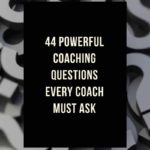Throughout my career, I’m certain of one thing: my mission is to make consultants just like you succeed. Do you know the most important thing that all successful consultants share? A model for consulting.
Consulting models are a straightforward way of conducting a consultation. The kind and type of model you select will make a huge difference to your clients. It can make your consulting process extremely effective. If you make the most of your time, you’ll be able to get more clients faster!
If you’re reading this, then congratulations! You’re now ready to fine-tune your consulting skills by choosing the best kind of consulting model.
There are many kinds of consultancy models you could apply to your consulting practice. The most popular models that we’ll be talking about include GROW, CLEAR, OSCAR and CIGAR. Today, we’ll explore each of these models to explore how they can enhance your consulting business.
A lot of consultants I have met were not sure about applying a consulting model at the time they first started. Therefore, before we speak about different kinds of consulting models, we should step back and learn the basics of models for consulting.
Do I require any kind of model for consulting in my practice?
YES!
Why? Because the term “consulting” could refer to different things to different people. Consulting is the act of being a facilitator as well as a guide. Consulting is viewed as a form of management. Consulting can also be a means to develop you and your customers.
If you want to achieve all of these, the ‘consulting model’ can help you become the type of expert your clients want you to be.
More and more, people are turning to consultants for help to gain knowledge and improve their lives. If you want your consultancy to be efficient, it’s essential that your clients have confidence in them.
What makes a prospective customer trust you?
Credibility!
And how do you increase your credibility?
With an original and reliable consulting model that fits your specific area of expertise and your preferred style of consulting.
Consulting is a market that is competitive. When you select the consulting model, it will make you more valuable than your competitors. If you can prove the importance of your consulting company, you’ll be able to get clients more quickly.
A model of consultation can assist your clients in visualizing the journey they will take with you. This will allow you to clearly demonstrate your worth. If you have a greater value, clients will feel confident about your ability to help them!
Consider selecting the best consulting model as a way of identifying your area of expertise!
Your industry + the perfect matching of the consulting model = more relevant and effective consulting = the success you deserve!
So, we know that selecting the right consulting model can make the difference to having a profitable consulting business. However, we must discuss something that is obvious. We’re discussing the various kinds of consulting models. We also have the styles of consulting, techniques for consulting as well as tools for consultation.
These terms could appear like they are the same, which could be difficult to understand, but it’s acceptable to be overwhelmed.
I’m here to assist you. Let’s examine the differences between these terms prior to we get into the depths and choose the best consulting model for your consulting business.
What is a ‘ Consulting Style‘
As a consultant, you will be bringing your unique persona and experience. You are able to make use of humor, wit, and a touch of charm. This is the most straightforward method to comprehend ‘consulting style.’
What is a ‘ Consulting Tool‘
A tool for consulting is one you can use in your practice of consulting. Tools for consulting help you run your consulting business. Think about the most fundamental operation of any consulting business: asking the correct questions. This is just one tool for consulting!
However, asking the correct concerns isn’t the only thing you need to do. It is essential to use online tools that will help you grow and expand your company. I’ve put together the following list of online tools that I personally tried, and I am sure it will benefit you the way it has helped me!
Check out the full listing of 40 Tools for Consulting to Expand your Consulting Business [2021 Edition]
You know the tools you use in your trade could be. What are the competencies needed to utilize these tools? In order to ask the appropriate questions, a consultant must be an outstanding “active listener”‘. These are the techniques you can use to consult!

Image taken from unsplash.com
Now, the main problem is.
What is a ‘Consulting Model’?
Consulting models are a method that you apply when you are advising your clients.
In simpler terms, the term “consulting model” is a mixture of:
Consulting Style
Consulting Tool
When you integrate these elements into a clear, step-by-step procedure, you’ll have the ‘type of consulting model which is simple to follow and understand.
A well-defined model for consulting is logical and makes the result evident.
In the simplest sense, a consultation model is a plan of engagement with your customers.
To allow any engagement to take place, it must have:
trust
hope
perception of value
competency
In a bit, we will go over different types of consulting models. We will also help you choose the best model for your needs.
When you begin with the correct consulting model, You will be able to establish credibility for your business.
By establishing credibility, you increase your trustworthiness. Then, you provide optimism and worth to your customers. They trust that your skills will assist them in achieving their objectives!
One of the primary reasons why people quit early is that they are worried about failing more than they want to succeed. A well-defined model for consulting will help in building confidence in your method. When your client is confident in the model you and your consultant have created, and your model, fear of failure will be an issue of the past!
Image from pexels.com
Benefits of choosing a type of consulting model in your practice
A great consultant is one who can help an individual move from the place they are towards where they want to be.
If you choose a consulting model, you’ll be able to see how you can assist your client in achieving their objectives. Each model is unique and has the benefit of having a clearly defined method you can employ to bring about changes for your clients.
Consulting models to help your clients establishes accountability
The benefits of having a model for consulting are:
- It is easy to measure ROI and performance. (return from investment)
- Always check your performance and not only your own, but also your client’s!
- Establish clear expectations for you and your customers.
- Simpler to manage agreements between you and your customers
- helps your clients to grow and improve their skills.
- effectively manage your time to make sure you are efficient
- Develop a mindset of growth, which is crucial for any transformation to occur
- It brings focus and clarity to any consulting business.
- Make sure your consultations are focused on strategies and is focused on service.
- A successful consulting model provides you with the ability to be flexible in your consulting work!
- aids in helping clients move forward when they get stuck with their issues or previous mistakes
Before we begin to look at the various kinds of models for consulting, I’d like to clarify this for you quickly.
There are no proper or incorrect kinds of models to consult.
Each model is unique and, when used correctly, will alter the dynamics in your consultancy business. The right model is much easier when you are aware of your market!
If you’re not already identified your niche in consulting, it can be a game-changer! Once you’ve found your area of expertise, the only thing you have to do is identify it the model of a consultant to find an effective formula.
I’ve created a thorough guide that any prospective consultant can follow to discover their own niche for consulting.
Read The Ultimate Guide To Finding Your Consulting Niche
Image from Unsplash.com
Let’s look at four types of models of consulting
- GROW
- CLEAR
- OSKAR
- CIGAR
Type of Consulting Model – GROW
The GROW Consultative Model has been by far the most well-known and popular model of consulting. It is a great representation of what your clients want, i.e., expanding. The method’s strategy is evident as its title suggests.
G – Goals
R – Reality
O – Options
W – Will
If you’re just beginning or wish to create a foundation model that will serve as your primary method of consulting GROW is the right model that is right for you!
Let’s look at this model:
G – Goals
The first thing to do is identify our purpose or what we would like to accomplish?
Ask your customers, “What does winning be to you?
R – Reality
Once we have determined the objective or desired outcome, it is time to evaluate the present state of affairs.
Ask your clients: Where do you stand in the process to win? Where are you in this journey towards your win?
O – Options
After we’ve established our current situation, We now have to consider all options available to us for moving toward our ‘wins’ that we have identified..
Ask your clients: What do you currently have to choose from? What are your current options?
Another way to incorporate “Options” is to include an element of “Obstacles” as you are preparing Your GROW Consulting Model. Another query for your clients is “What are the biggest obstacles you are expecting to face on the way toward your success?
W – Will
This step is evident! Ask your clients, “What are you going to do today? ‘.
The most important goal at this stage is to help your clients comprehend how they can progress from their current situation and toward their goals and still keep in mind their options or Obstacles.
It is possible to approach this model in a fluid-structure or as an ongoing process. You could even apply this model to incorporate the aspect of accountability by requiring your client’s goals to be real and quantifiable. You can make a thorough listing of the options and resources and options. Another method to make the model more precise is to create a timeline in the final step of the ‘Will’.
It’s easy to see the reason why this kind of consulting model is attractive because it’s easy and effective!
Type of Consulting Model – CLEAR
This CLEAR Consulting Model concentrates on the beginning stages of contracting with clients as well as setting up expectations. This kind of model is particularly effective for clients who are clear about what they would like to achieve. How do they get the goals they have set? This is where you can help by offering this model of consulting!
C – Contracting
L – Listening
E – Exploring
A – Action
R – Review
Image from unsplash.com
Let’s take a look at our options for CLEAR Consulting Model
C – Contracting
Sometimes the engagement of the same client’s consulting may last for a minimum of six months. At times clients may arrange an appointment and even pay for the consultation session, but they don’t show on time. This aspect of the CLEAR Consulting Model aids in setting expectations with your clients. By using this contracting method, you can establish the ground rules and establish accountability.
L – Listening
Listening is the foundation of the practice of consulting. To flourish as a competent consultant, you must begin by developing your listening abilities.
One of the most difficult aspects of listening actively is the ability to be able to block your judgment while your client interacts with you. Instead of judging, active listening focuses on the message that the client is trying to convey and what the significance of that message is to them.
“Listen with the intent to understand, not to reply.” — Stephen Covey (7 Habits of Highly Effective People)
The best tools to be successful in Listening actively. Listening:
Paraphrasing is when you retell their story to demonstrate that you fully comprehend the message. You can choose your timings and phrases carefully and also summarize your client’s message.
Reflection is when you analyze and reflect on the most important emotion of their message. The emotion could be either positive or negative. In reflecting on it, you’re expressing your gratitude to your client’s circumstances.
Probing, in which you stop the narration and ask questions to follow up on the thoughts of the participants. Questions for probing are generally open-ended. They can help guide your client to achieve their goals and goals.
Active Silence. In which you turn your back and let your client speak about their experiences in a comfortable manner. Active silence can also be helpful for asking broad-ranging questions.
It’s a very simple trick to use your brain. If you stop and then keep your silence, it serves as a prompt or series of questions. The silence you maintain can prompt your clients to keep delivering their message, typically with no limitations.
E – Exploring
This stage of the CLEAR Consulting Model is about analyzing the context and situation for your clients. The process of exploring isn’t only about saying the obvious. It is about figuring out the reason and the how of your client’s circumstances. It is also about understanding the effect of their situation on their life is.
In addition, this process could also involve exploring options and options for your client’s objectives.
A – Action
Here’s one of the best aspects of this particular consulting model! The time and place where your clients can begin the journey to transform their lives. The stage of action!
In this phase, it is your responsibility to support your client in the steps they’re taking to achieve their goals.
R – Review
The final stage of this model of consulting is very fluid. There are a variety of methods for looking over any post-event circumstance or procedure. The most commonly used method that has proven to be effective in the majority of cases is:
What was the best part?
What did you learn?
What can you do to improve your service to come back in the near future?
The Review stage allows your clients to offer feedback. The feedback doesn’t only focus on the role you play as an advisor in their lives. Feedback from this step is feedback about the process as well as the results from each step that the process follows.
Are you aware of the most effective feature of this entire model? It operates in the circular format as opposed to a linear one. It means that you could apply this model to the entire consultation process, OR you can apply it to guide your client’s actions in line with their objectives.
The Review process can give insight for the next phase of the CLEAR consultation process regardless of whether it’s to be conducted for the exact same person.
In addition, you have the option of having a CLEAR method for each stage of Exploring, Listening and Taking action in the framework!
Let’s take a look at the ACTION stage within the CLEAR consulting model. It is easy to set up an agreement of contract to define the action your client takes. Listening and exploration will help your client understand the implications of their actions. This is the same action that they’ve agreed on within the larger context in CLEAR. CLEAR model. After your clients take action, you’ll begin to work on the review phase and complete the loop.
Following this, you are able to proceed to Action item 2 of the CLEAR process or the Review phase of the process in general.
Type of Consulting Model – OSCAR
This OSCAR Consulting Model focuses on the outcomes, solutions and the outcomes you want that your client will enjoy. This kind of model is ideal for clients who are clear on what they are looking for. What they require is professional guidance on how to achieve their goals effectively
O – Outcome
S – Situation
C – Choices/Consequences
A – Actions
R – Review
Let’s examine this model:
Image from unsplash.com
O – Outcome
The first step in using the OSCAR Consulting Model is to establish your customer’s objectives, results, and objectives. This is mostly a client-centric step. Your client will begin by describing the goals they want to achieve and the outcomes they would like to achieve. This process is usually viewed as part of the problem they are confronting.
Ask your client: What do you want to achieve or the desired outcome you want us to be focused on?
S – Situation
After your client has explained their goals, we can move on to evaluate their current situation. It could also include questions about their surroundings and any favorable circumstances.
Ask your client what is currently happening in your life that is making it difficult for you to connect with the outcome?
Alternately, you could inquire, “On a scale of one to 10 in which 10 represents your final result, How far are you toward achieving your goal?’
C – Choices/Consequences
This is the one that is most exciting and engaging in the entire procedure. At this point, your client can outline the various choices they have to make to attain the desired outcomes. These choices are typically assessed in relation to the current circumstances. With regards to the choices, it is possible to look at the potential consequences of the decisions made!
Ask your client: ‘If you had to make just one choice toward achieving your Goal, What would it be?
A – Actions
Your client has made the most suitable choice they wish to pursue toward their goal. The next step is creating a plan of the course of action.
To get a better understanding of this Let’s go through the same scale-based query during the ‘Situation’ step. Let’s suppose that your client has realized that they’re on number 7 as of right now. This means they need to earn three more points to reach number 10 on this scale.
Then you can ask your client what steps you will undertake to progress toward number 9, number 8? Then, lastly, towards the ultimate goal of number 10 What are your goals?
R – Review
As part of the OSCAR Consulting Model, the review phase is vital. By conducting effective reviews, you’ll be able to make sure that your client keeps their attention on their ultimate objectives. You can determine whether they have the same motivation to work toward number 8, number 9, and finally, number 10!
The only question you should never ask your customers is, ‘Are your there yet Do you have a plan?
Remember that the review stage is distinct from micro-management.
This review phase is best when the alternatives and actions formulated in the earlier step are measurable to assess the effectiveness and reward.
This stage of this step of the OSKAR Consulting Model is a continuous process of reviewing, feedback, and returning to the structure. This loop of constant feedback will assist your clients in keeping their attention on the ultimate purpose.
The OSCAR model of consultation can be beneficial for clients with an objective or goal that is well-thought-out.
Type of Consulting Model – CIGAR
In a sense in a way, in a way, the CIGAR Consulting Model has evolved from the GROW consulting model. The distinctive benefit that the CIGAR methods of consulting provide is a deep examination of the current situation and the best solutions. If we place a lot of emphasis on the current situation vs the future, the client is able to adopt an analytical mindset that can be beneficial to any client.
C – Current Reality
I – Ideal
G – Gaps
A – Action
R – Review
Let’s look at this model:
C – Current Reality
As the name implies, the first step in the CIGAR Consulting Model is to examine and establish the current situation for your customer. The primary question to be addressed is ‘Where do we stand right now? What is the current situation?
I – Ideal
We’ve achieved the present reality. The second step will be to imagine the ideal.
The main question here is: Where would you like to be at the moment?
I’ll reveal an insider tip here. Want better results? Ask your clients to imagine their ideal scenario in the event that they’ve already accomplished it. Instead of saying, “My ideal scenario is to be full-time as an expert in sports, they should instead claim that they are a full-time, successful sports consultant and I’m bringing tremendous value to all of my clients’. Notice the difference? It works every time!
G – Gaps
Being able to clearly see the goal of your client is exciting, right. But before we can draw an outline of how to achieve this goal, it is important to discover the areas that may result in delays. The main question is: “What do you see as the gaps in your present situation and your ideal?
This can be a difficult step for clients. Utilize a combination of probing questions and active silence to motivate your client to deeply investigate the areas of their life.
A – Action
It is easy to do this when your client is aware of the gaps they have to overcome. Your job as a professional here is to assist your clients in guiding them, showing how to proceed, and increasing their chances of eliminating any holes in their narrative!
R – Review
The final stage of the model of CIGAR Consulting is to examine the whole procedure. It is possible to focus on the efforts they put into overcoming the obstacles to reach what they envision for their scenario. and the client.
While consulting models allow you to be extremely flexible, they should not be viewed as rigid frameworks.
Stay committed to your decisions, but stay flexible in your approach – Tony Robbins









![Arrangements-centered Consulting: 5 successful strategies [2022 Edition] Consulting model Arrangements-centered Consulting: 5 successful strategies [2022 Edition] Consulting model](https://consultantfoundation.com/wp-content/uploads/2020/09/Copy-of-consultant-2020-09-25T025425.189-150x150.jpg)
